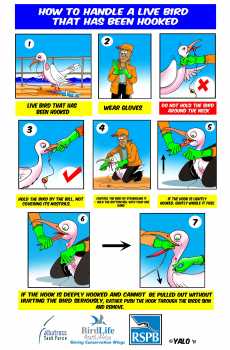Although long-line fishing operations can greatly reduce seabird mortality by adopting the best-practice mitigation methods of line weighting, night setting and deploying bird-scaring lines, seabirds can still get caught on baited hooks, and some caught during line hauling can come aboard alive. A problem then exists of how best to unhook the bird and release it as little harmed as possible.
South African-based Bronwyn Maree of BirdLife International's Albatross Task Force has been distributing a cartoon to help educate especially recreational fishers on how to hold and unhook a bird.

She reports: "[w]e then had the idea of creating a cartoon which could be easily understood by people with different languages, operating in different fisheries and with different levels of education, outlining the safest methods to release seabirds for both people and the birds. This had a massive impact - we spread this through electronic forums, clubs, nature organisations and volunteers who were willing to drop some copies off in the local harbours. We continue to drop these off when conducting our harbour visits or when doing one of our sea trips ...but since then we have not received any more complaints...but continue to keep an eye out as our work continues! We can see that by giving the fishermen the correct tools we can all win!" (click here).
With thanks to Oli Yates for information.
John Cooper, ACAP Information Officer, 22 July 2012

 English
English  Français
Français  Español
Español